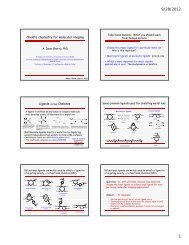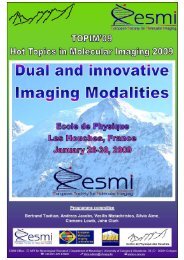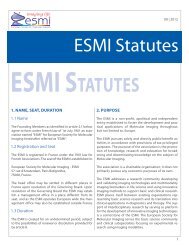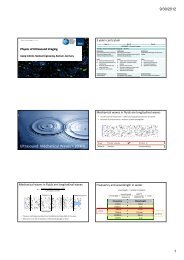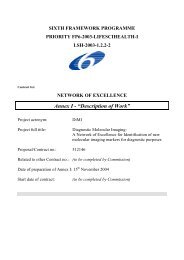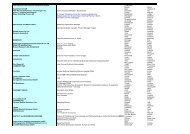- Page 1 and 2: of the European network of excellen
- Page 3 and 4: content - per topic 5th EuropEan Mo
- Page 5 and 6: Parallel Session 5: NEUROSCIENCE II
- Page 7 and 8: Dear Colleagues, 5th EuropEan MolEc
- Page 9 and 10: 5th EuropEan MolEcular IMagIng MEEt
- Page 11 and 12: EuropEan SocIEty for MolEcular IMag
- Page 13 and 14: 5th EuropEan MolEcular IMagIng MEEt
- Page 15 and 16: 14:30-16:00 16:00-17:00 17:00-18:00
- Page 17 and 18: 20 WarSaW, poland May 26 - 29, 2010
- Page 19 and 20: DAY 1
- Page 21: 24 WarSaW, poland May 26 - 29, 2010
- Page 25 and 26: 28 Introduction: WarSaW, poland May
- Page 27 and 28: YIA applicant 30 Introduction: WarS
- Page 29 and 30: 32 Detailed WarSaW, poland May 26 -
- Page 31 and 32: YIA applicant 34 WarSaW, poland May
- Page 33 and 34: 36 Introduction: WarSaW, poland May
- Page 35 and 36: 38 Introduction: WarSaW, poland May
- Page 37 and 38: 40 WarSaW, poland May 26 - 29, 2010
- Page 39 and 40: 42 Introduction: WarSaW, poland May
- Page 41 and 42: 44 Magnetic WarSaW, poland May 26 -
- Page 43 and 44: 46 WarSaW, poland May 26 - 29, 2010
- Page 45 and 46: YIA applicant 48 Introduction: WarS
- Page 47 and 48: 50 Education WarSaW, poland May 26
- Page 49 and 50: 52 Introduction: WarSaW, poland May
- Page 51 and 52: YIA applicant 54 Introduction: WarS
- Page 53 and 54: YIA applicant 56 WarSaW, poland May
- Page 55 and 56: DAY 2
- Page 57 and 58: 60 WarSaW, poland May 26 - 29, 2010
- Page 59 and 60: 62 WarSaW, poland May 26 - 29, 2010
- Page 61 and 62: YIA applicant 64 WarSaW, poland May
- Page 63 and 64: YIA applicant 66 WarSaW, poland May
- Page 65 and 66: 68 WarSaW, poland May 26 - 29, 2010
- Page 67 and 68: YIA applicant 70 WarSaW, poland May
- Page 69 and 70: YIA applicant 72 WarSaW, poland May
- Page 71 and 72: 74 WarSaW, poland May 26 - 29, 2010
- Page 73 and 74:
76 WarSaW, poland May 26 - 29, 2010
- Page 75 and 76:
78 WarSaW, poland May 26 - 29, 2010
- Page 77 and 78:
80 WarSaW, poland May 26 - 29, 2010
- Page 79 and 80:
82 WarSaW, poland May 26 - 29, 2010
- Page 81 and 82:
YIA applicant 84 WarSaW, poland May
- Page 83 and 84:
86 WarSaW, poland May 26 - 29, 2010
- Page 85 and 86:
88 WarSaW, poland May 26 - 29, 2010
- Page 87 and 88:
90 WarSaW, poland May 26 - 29, 2010
- Page 89 and 90:
DAY 3
- Page 91 and 92:
94 WarSaW, poland May 26 - 29, 2010
- Page 93 and 94:
96 WarSaW, poland May 26 - 29, 2010
- Page 95 and 96:
98 WarSaW, poland May 26 - 29, 2010
- Page 97 and 98:
100 WarSaW, poland May 26 - 29, 201
- Page 99 and 100:
102 WarSaW, poland May 26 - 29, 201
- Page 101 and 102:
104 WarSaW, poland May 26 - 29, 201
- Page 103 and 104:
YIA applicant 106 WarSaW, poland Ma
- Page 105 and 106:
poster
- Page 107 and 108:
110 WarSaW, poland May 26 - 29, 201
- Page 109 and 110:
112 WarSaW, poland May 26 - 29, 201
- Page 111 and 112:
P-001 114 WarSaW, poland May 26 - 2
- Page 113 and 114:
P-003 116 WarSaW, poland May 26 - 2
- Page 115 and 116:
P-005 118 WarSaW, poland May 26 - 2
- Page 117 and 118:
WarSaW, poland May 26 - 29, 2010 P-
- Page 119 and 120:
122 WarSaW, poland May 26 - 29, 201
- Page 121 and 122:
124 WarSaW, poland May 26 - 29, 201
- Page 123 and 124:
126 WarSaW, poland May 26 - 29, 201
- Page 125 and 126:
128 WarSaW, poland May 26 - 29, 201
- Page 127 and 128:
130 WarSaW, poland May 26 - 29, 201
- Page 129 and 130:
WarSaW, poland May 26 - 29, 2010 P-
- Page 131 and 132:
WarSaW, poland May 26 - 29, 2010 P-
- Page 133 and 134:
136 WarSaW, poland May 26 - 29, 201
- Page 135 and 136:
138 WarSaW, poland May 26 - 29, 201
- Page 137 and 138:
140 WarSaW, poland May 26 - 29, 201
- Page 139 and 140:
142 WarSaW, poland May 26 - 29, 201
- Page 141 and 142:
P-031 144 WarSaW, poland May 26 - 2
- Page 143 and 144:
WarSaW, poland May 26 - 29, 2010 P-
- Page 145 and 146:
148 WarSaW, poland May 26 - 29, 201
- Page 147 and 148:
P-037 150 WarSaW, poland May 26 - 2
- Page 149 and 150:
152 WarSaW, poland May 26 - 29, 201
- Page 151 and 152:
154 WarSaW, poland May 26 - 29, 201
- Page 153 and 154:
156 WarSaW, poland May 26 - 29, 201
- Page 155 and 156:
158 WarSaW, poland May 26 - 29, 201
- Page 157 and 158:
160 WarSaW, poland May 26 - 29, 201
- Page 159 and 160:
P-049 162 WarSaW, poland May 26 - 2
- Page 161 and 162:
WarSaW, poland May 26 - 29, 2010 P-
- Page 163 and 164:
WarSaW, poland May 26 - 29, 2010 P-
- Page 165 and 166:
168 WarSaW, poland May 26 - 29, 201
- Page 167 and 168:
WarSaW, poland May 26 - 29, 2010 P-
- Page 169 and 170:
172 WarSaW, poland May 26 - 29, 201
- Page 171 and 172:
WarSaW, poland May 26 - 29, 2010 P-
- Page 173 and 174:
WarSaW, poland May 26 - 29, 2010 P-
- Page 175 and 176:
178 WarSaW, poland May 26 - 29, 201
- Page 177 and 178:
WarSaW, poland May 26 - 29, 2010 P-
- Page 179 and 180:
182 WarSaW, poland May 26 - 29, 201
- Page 181 and 182:
184 WarSaW, poland May 26 - 29, 201
- Page 183 and 184:
P-073 186 WarSaW, poland May 26 - 2
- Page 185 and 186:
P-075 188 WarSaW, poland May 26 - 2
- Page 187 and 188:
WarSaW, poland May 26 - 29, 2010 P-
- Page 189 and 190:
192 WarSaW, poland May 26 - 29, 201
- Page 191 and 192:
194 WarSaW, poland May 26 - 29, 201
- Page 193 and 194:
196 WarSaW, poland May 26 - 29, 201
- Page 195 and 196:
WarSaW, poland May 26 - 29, 2010 P-
- Page 197 and 198:
200 WarSaW, poland May 26 - 29, 201
- Page 199 and 200:
202 WarSaW, poland May 26 - 29, 201
- Page 201 and 202:
204 WarSaW, poland May 26 - 29, 201
- Page 203 and 204:
206 WarSaW, poland May 26 - 29, 201
- Page 205 and 206:
WarSaW, poland May 26 - 29, 2010 P-
- Page 207 and 208:
210 WarSaW, poland May 26 - 29, 201
- Page 209 and 210:
212 WarSaW, poland May 26 - 29, 201
- Page 211 and 212:
214 WarSaW, poland May 26 - 29, 201
- Page 213 and 214:
216 WarSaW, poland May 26 - 29, 201
- Page 215 and 216:
P-105 218 WarSaW, poland May 26 - 2
- Page 217 and 218:
P-107 220 WarSaW, poland May 26 - 2
- Page 219 and 220:
index
- Page 221 and 222:
ANIMASCOPE High TECHNOLOGY for High
- Page 223 and 224:
226 WarSaW, poland May 26 - 29, 201
- Page 225 and 226:
228 WarSaW, poland May 26 - 29, 201



